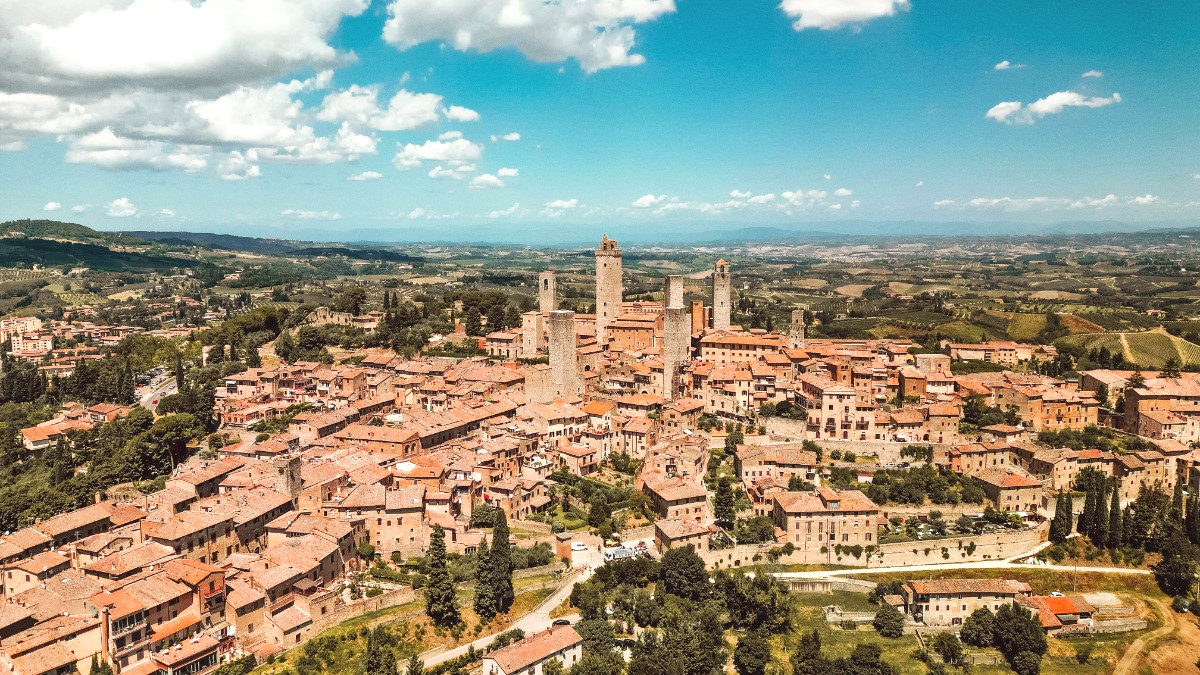
Tuscany, Italy
When you approach, the town's distinct profile, with its remaining fourteen towers, immediately captivates. It presents an invitation to experience history, culture, and nature in one remarkable setting. This guide outlines the discovery of San Gimignano, from its iconic landmarks to its hidden corners. Explore a place where every cobblestone has a tale, and every view is a masterpiece.
San Gimignano sits in the heart of Tuscany, a region of Italy celebrated for its beauty. The town is approximately 56 kilometers, or 35 miles, south of Florence. Siena, another historic city, lies about 40 kilometers, or 25 miles, to the northwest. This walled medieval town perches on a hill in the Val d'Elsa, a picturesque valley.
Its elevation of 334 meters, or 1,096 feet, above sea level provides natural defenses and expansive views. The surrounding landscape typifies Tuscany, with neatly arranged vineyards, shimmering olive groves, and rolling hills. The town's strategic location along the Via Francigena, an old pilgrimage route, contributed to its historical significance.
San Gimignano's history dates back to ancient Etruscan times, developing into a thriving Roman village before its medieval rise. In the 12th century, it became an independent commune. Its strategic position on the Via Francigena, the pilgrim route to Rome, brought immense wealth and influence. Pilgrims, merchants, and armies passed through its gates, transforming the town into a bustling commercial center. Trade in saffron and local Vernaccia wine fueled its prosperity.
The town's striking towers tell a story of intense civic rivalry. Wealthy aristocratic families, both Guelphs and Ghibellines, built these towering structures. Each tower represented a family's wealth, influence, and defensive capability. At its peak, San Gimignano boasted 72 towers. A period of economic decline after the Black Death in 1348, ironically, led to its remarkable preservation. Unable to afford extensive modernization, San Gimignano largely retained its medieval appearance. In 1351, the town submitted to Florentine rule, losing independence but gaining stability. This cessation of new development effectively froze San Gimignano in time.
Early settlement and Roman village development.
Assertion of autonomy amidst feudal lords.
Pilgrim route bringing wealth and trade.
Up to 72 towers, symbols of family power.
Recognition of preserved medieval urban center.
The town's enduring historical value received formal recognition in 1990. The Historic Centre of San Gimignano holds designation as an UNESCO World Heritage Site. This status acknowledges its exceptional example of a medieval urban center, preserving its original architectural character and urban structure. Today, the remaining 14 towers, along with its ancient walls, public squares, and churches, provide a tangible link to its glorious and turbulent past.
Saffron and Vernaccia di San Gimignano wine were main drivers of medieval prosperity. Today, tourism is the backbone of the local economy, attracting visitors globally. Agriculture also maintains a strong position, especially the cultivation of wine grapes for Vernaccia and Chianti, olive groves for olive oil, and saffron.
The town's inability to afford extensive modernization after the Black Death led to its remarkable preservation. This historical circumstance allowed its medieval architecture to survive almost untouched for centuries, creating a living museum experience for today's visitors.
Visiting San Gimignano is not just seeing old buildings; it is walking through a living museum, where the echoes of medieval life still resonate.
San Gimignano offers a concentrated experience of Tuscan history and culture. Here is a brief look at some facts about this town:
San Gimignano continues to thrive as a center of cultural heritage and agricultural tradition.
Situated in the heart of Tuscany, Italy.
Its Historic Centre was named an UNESCO World Heritage Site in 1990, a recognition of its outstanding universal value.
Well-preserved medieval architecture, 14 remaining towers, Vernaccia di San Gimignano wine, and saffron production.
Tourism forms the backbone of the local economy. Agriculture also is a strong position, notably the cultivation of wine grapes for Vernaccia and Chianti, olive groves for olive oil, and saffron.